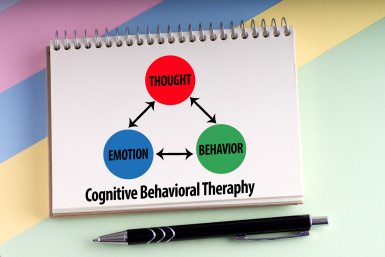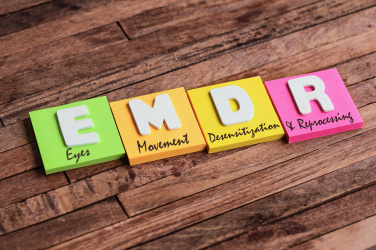Our Therapeutic Modalities:
Traditional Therapies:
Cognitive Behavioral Therapy (CBT):
CBT focuses on challenging and changing unhelpful cognitive distortions (e.g. thoughts, beliefs, and attitudes). CBT focuses on how these distortions link to emotions and behaviors thereby helping the client to achieve greater emotional regulation and overall harmony in their life.
CBT helps the client become aware of inaccurate or negative ways of thinking so they can view challenging situations more clearly and respond to them in a more productive effective way. This approach focuses on present circumstances and emotions, rather than focusing on the patient’s childhood.
CBT can be particularly effective when working on overcoming addictions. While addiction is typically manifest in physical forms, most addicts have underlying, destructive mental patterns and habits that must be identified and changed before freedom from dependency can be obtained. Whether the drug of choice is alcohol, drugs, pornography, gambling or tobacco, cognitive therapy can be successful in changing patterns from destructive and dangerous to productive. During cognitive therapy our therapists work to break down the negative thinking cycle and replace bad patterns with healthy, new behaviors that stop the addiction. In order for treatment to truly be successful, the addict and their loved ones must understand why the compulsion to use drugs/pornography/etc. is present.
Dialectical Behavioral Therapy (DBT):
DBT was developed to help clients improve and regulate their emotions, allowing for more tolerance of distress and negative emotion. This allows the person to be mindful and present within the moment thus improving communication and the ability to better interact and connect with others. Essentially, the therapy gives the person new skills that the person can use to help with managing emotions that are painful and decrease relationship conflicts in a person.
DBT was originally developed for work with adolescents but it has easily been adapted to the wider population at large and is used to treat depression, eating disorders, bipolar disorder, panic, anxiety and PTSD.
Four key elements are focused on in DBT:
- Mindfulness: this aims to improve the ability to accept and be present within the moment
- Distress Tolerance: this is geared towards increasing the tolerance for negative emotion, rather than trying to escape it
- Emotional Regulation: a means and strategy used to manage and change the emotions that are super intense and creating a problem in a person's life
- Interpersonal Effectiveness: techniques that allow someone to communicate with others in a way that is assertive, allows for self-respect to be maintained, and strengthen the relationship of a person
Marriage and Couples Therapy Modalities:
Emotion Focused Therapy (EFT):
EFT was developed in 1998 by Sue Johnson and colleagues and is best known as a cutting edge, tested, and proven couples intervention. It is also used to address individual depression, anxiety, post traumatic stress disorder, and to repair family bonds.
EFT holds to the philisophy that relationships are at the core of human experience and that supporting and developing emotional bonds is key not only to relationships, but to mental and physical health overall.
Attachment is emerging as simply the best guide we have to who we are and how we connect to others. Lack of secure attachment has emerged as a risk factor for every form of mental health problem, whilst a sense of secure connection with others has been linked to resilience and a more coherent positive sense of self. EFT uses attachment science as a map to make sense of problems by simplifying complex narratives of dysfunction and negative relationship cycles. It offers a clear, simple set of interventions that have been shown to create intrapsychic and interpersonal change.
The Gottman Method:
Gottman marriage therapy is based on the extensive life-long research and works of Drs. John and Julie Gottman. The goals of Gottman Method Couples Therapy are to disarm conflicting verbal communication, remove barriers that create a feeling of stagnancy in conflicting situations, and create a heightened sense of empathy, understanding, intimacy, respect, and affection within the context of the relationship.
Interventions are designed to help couples strengthen their relationships in three primary areas: friendship, conflict management, and creation of shared meaning. Couples learn to replace negative conflict patterns with positive interactions and to repair past hurts. Interventions designed to increase closeness and intimacy are used to improve friendship, deepen emotional connection, and create changes which enhances the couples shared goals. Relapse prevention is also addressed.
Each couple will begin their Gottman Marriage Therapy treatment by completing a comprehensive online marriage analysis on the Gottman Marriage Website. (This is included in your marriage counseling fees and paid for by our office). Your initial appointment will be together and then your clinician will meet with each partner in an individual session to continue the thorough intake assessment. Your clinician will then review the results of your previously completed analysis and overall online assessment with you in detail in your fourth appointment. Treatment plans and goals will be set based on the areas this research assessment helps to highlight and based on the information provided by the couple.
Some of the relationship issues that may be addressed in this type of therapy include:
- Frequent conflict and arguments
- Poor communication
- Emotionally distanced couples on the verge of separation
- Specific problems such as sexual difficulties, infidelity, money, and parenting
Even couples with “normal” levels of conflict may benefit from the Gottman Method Couples Therapy. Gottman-trained therapists aim to help couples build stronger relationships overall and healthier ways to cope with issues as they arise in the future.
Ego State Therapies:
EMDR Therapy:
Eye Movement Desensitization and Reprocessing (EMDR) therapy is an extensively researched, effective psychotherapy method proven to help people recover from trauma and other distressing life experiences, including PTSD, anxiety, depression, addiction, and panic disorders.
It is recognized by The American Psychiatric Association, the International Society for Traumatic Stress Studies, the U.S. Dept. of Veterans Affairs/Dept. of Defense, and the World Health Organization among many other national and international organizations as one of the most effective treatments for trauma.
One of the procedural elements of EMDR is “dual stimulation” using either bilateral eye movements, tones, or taps. During the reprocessing phases the client attends momentarily to past memories, present triggers, or anticipated future experiences while simultaneously focusing on a set of external stimuli. During that time, clients generally experience the emergence of insight, changes in memories, or new associations.
EMDR therapy does not require talking in detail about the distressing issue or completing homework between sessions. EMDR therapy, rather than focusing on changing the emotions, thoughts, or behaviors resulting from the distressing issue, allows the brain to resume its natural healing process. EMDR is a highly effective not only for trauma, but also for anxiety, depression, addictions, and abuse.
Developmental Needs Meeting Strategy (DNMS):
DNMS is a multi-dimensional, comprehensive, strength-based, client-centered, ego state therapy. This therapy was developed in 2000 by Shirley Jean Schmidt an EMDR therapist who began to wonder if clients were stuck in adverse childhood experiences because of trauma or because of unmet developmental needs. Her
breakthrough work has led to this unprecedented gentle and profoundly healing therapy.
In this therapy clients will return to childhood experiences, connect and communicate with childhood parts, mobilize an internal adult resource team, and help meet un-met childhood needs in the present for their wounded past parts of self. Child ego states (parts) stuck in wounding childhood experiences are at the core of emotional dysregulation.
This model is based on the assumption that children have physical, emotional, social, and intellectual needs at each stage of development. When caregivers meet those needs well, children thrive. When caregivers fail to meet needs well enough, they suffer. The degree to which developmental needs were not adequately met is the degree to which a part of self can become stuck in childhood. Being stuck means that behaviors, beliefs, or emotions connected to unresolved wounds from the past can get triggered and disrupt relationships and connections in the present day.
DNMS is designed to treat a wide range of issues and is extremely effective in treating:
- Complex Trauma Wounds - such as those inflicted by verbal, physical, and sexual abuse.
- Attachment Wounds - such as those inflicted by parental rejection, neglect, and enmeshment.
- Borderline Personality Disorder - DNMS has been proven to effectively stabilize wounded parts of self that drive BPD.
- Dissociative Disorders - including Dissociative Identity Disorder.
- A wide range of other symptoms and issues including but not limited to: depression, anxiety, social phobia, complex PTSD, relationship trouble, obsessions/compulsions, eating disorders, self-injurious behaviors, and complicated grief.







